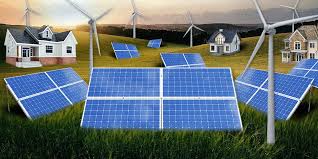Oil & Energy
‘Renewable Energy Land Rush Could Threaten Food Security’

Meeting global climate goals will require an unprecedented buildout of energy infrastructure in terms of both speed and scale. And, while the energies themselves may be renewable, their construction, production, and maintenance requires a whole lot of finite resources, from rare Earth minerals and metals to the very land they are built on.
This last issue regarding mass-scale land use and acquisition, in particular, is already one of the biggest hurdles facing the global decarbonisation transition.
As the renewable revolution picks up pace, more and more land is required for conversion to utility-scale solar and wind farms. This is becoming extremely tricky, extremely fast in a world that is increasingly competing for scarce land area, especially considering that solar and wind farms need land that is both well-suited to their particular climatic and geographic needs and large enough to make the project worthwhile.
According to a report from global consulting powerhouse, McKinsey & Company, utility-scale solar and wind farms require a whopping 10 times as much land as a typical coal or natural gas power plant. And that includes the land required for production as well as transportation of those fossil fuels.
“Wind turbines are often placed half a mile apart, while large solar farms span thousands of acres.
“The implications of this are daunting. Developers need to continuously identify new sites with increasing speed at a time when the availability of suitable, economically desirable land is getting tighter”, the report states.
And the energy sector isn’t the only sector that needs those large and sunny land plots. Renewable energy projects are often competing for some of the most valuable agricultural land, presenting serious challenges and trade-offs among two of the world’s most critical sectors.
A recent deep-diving Reuters analysis based on huge swaths of data and key stakeholder interviews reveals that the renewable energy boom risks damaging some of the United States’ richest soils in its most important farming states.
Solar farms clear huge areas of land of all vegetation, making the soil extremely vulnerable to erosion and allowing precious topsoil to simply dry up and blow away, threatening dust-bowl conditions and a total loss of future agricultural viability in affected areas.
The loss of this topsoil cannot be reversed in any meaningful timeline. “The reality is that it takes thousands of years to create an inch of fertile topsoil”, warns National Geographic, “but it can be destroyed in minutes”.
At its most basic level, it’s an issue of economics. On the whole, farmers struggle to make a profit through agriculture and largely rely on federal support and subsidies to stay afloat.
But if they sell or lease their land for conversion to renewable energy production projects, they stand to make a much bigger paycheck. Regardless of whether it’s actually the best use of the land or the best decision for the United States’ food security, it’s certainly the best financial decision for the landholder.
In a business-as-usual scenario, forecasts show that 83% of new solar energy development in the U.S. will be on farm and ranchland, according to researchers from the American Farmland Trust.
Nearly half of that land is the country’s most prime agricultural land. The non-profit farmland protection agency lobbies for what they call “Smart Solar” instead of indiscriminate solar expansion.
A sharp shift in policy will be necessary to ensure that solar expansion works alongside the farming industry to maintain critical agricultural heartlands.
“The key question for our national solar buildout is not ‘if,’ but ‘how’”, said Tim Fink, Policy Director of the American Farmland Trust.
“Our nation’s renewable energy transition is happening quickly, and solar energy is a significant part of it. We must act in the next Farm Bill to ensure that this transition benefits farmers, farmland, and farm communities”, he stated.
One such solution is the employment of agrivoltaics, which are synergistically combined solar and agriculture systems. In this symbiotic relationship, crops benefit from the shade of solar panels, while the panels are assisted by the natural cooling that the plants provide as they release water through transpiration, which serves to increase their photovoltaic efficiency.
Critically, this system eliminates the tactic of clear-cutting the farmland, safeguarding the topsoil.
Zaremba writes for Oilprice.com.
By: Haley Zaremba
Oil & Energy
Navy Nabs Six Oil Thieves, Dismantles Illegal Refining Site

The Nigerian Navy Units under the auspices of Operation Delta Sanity says it has recorded significant successes against crude oil theft and illegal refining sites in the Niger Delta.
The Navy, in an updated operations, said the successes were recorded between Thursday August 29 and Monday September 2, 2024.
According to the information, on 29th August, seven large cotonou and two fibre boats operated by heavily armed oil thieves loading crude oil from an illegal loading point around Botokiri axis of Nembe Local Government Area of Bayelsa State were seized.
Also, on 31st August, six suspected crude oil thieves with 109 sacks of illegally refined petroleum products, four fibre boats and two wooden boats were arrested and seized along Ogboinbiri-Kasama-Azama-Isoni of Bayelsa State.
Again, on 1st September, two wooden boats and 328 sacks of illegally refined automated Gas Oil were seized at Otuogori community’s river bank in Yenagoa, Bayelsa State.
Additionally, on 2nd September, 35 sacks of illegally refined Automotive Gas Oil in a wooden boat were seized at Gbaraun area of Southern Ijaw Local Government Area of Bayelsa State.
These successes indicate the effectiveness of Operation Delta Sanity, and the resolve of the Nigerian Navy to sustain current efforts to rid Nigeria’s maritime environment of the menace of crude oil theft and enhance crude oil production for the overall growth of the economy.
Oil & Energy
Security Agencies, MDAs Owe Eko DISco N42bn – BPE

The Eko Electricity Distribution Company Plc. has clarified that the Ministries, Departments, and Agencies of the Federal Government, including the military, owed the power distribution company N42billion as the cost of electricity consumed and not N144billion.
The Bureau of Public Enterprise(BPE), disclosed this in a Statement signed by the Head, Public Communications, Amina Othman, at the Weekend.
According to the Statement, the Disco affirmed that its total outstanding debt was N144billion, of which the MDAs and the military owe N42billion.
“The Eko Electricity Distribution Company Plc has clarified that contrary to earlier reports, the aggregate outstanding debt owed by consumers is N144billion, out of which, ministries, departments, and agencies including the military owe N42billion”, Othman stated.
The Statement said this was against prior reports that the MDAs, including the army, police, and other government agencies, were owing N144billion and had refused to pay.
The Disco said, “the clarification became necessary for proper reportage on the matter and to put the records straight”, it stated.
Recall that during a recent oversight visit by members of the House of Representatives Committee on Privatisation and Commercialisation, led by its Chairman, Ibrahim, the Acting Managing Director of the EKEDC, Mrs. Rekhiat Momoh, among other things, informed the members about the legacy debts owed the company by MDAs.
The committee had reported the acting MD as stating that the company was owed N144billion by MDAs within its operational area, saying she mentioned that the military, police, and various state government agencies failed to settle their debts, creating financial difficulties for the distribution company.
Oil & Energy
Unveiling Of Crane: Energy Infrastructure Set To Get Boost

Energy infrastructure, a crucial part of global oil and gas supply and the energy transition, are set to get a boost after a heavy lifting equipment provider unveiled the world’s strongest crane-equipment capable of lifting 6,000 tons, or 15 fully loaded Boeing 747 aircraft.
Dutch heavy lifting and transport services company Mammoet has launched a new type of crane, the SK6,000, which, the firm said, could be used for modules to be built faster and also “bigger than ever before”.
As oil and gas continue to be a key part of the world’s energy system—and likely will continue for decades to come—and as renewable energy developers aim for bigger wind turbines, the support equipment for installing oil and gas platforms, offshore wind equipment, and even nuclear power stations is becoming bigger.
Bigger cranes such Mammoet’s SK6,000 could remove some of the limitations of engineering and construction firms. These firms are generally limited by how much weight can be lifted when installed on a platform or turbine.
Cranes that can carry 5,000 tons and more can shorten the time of a project being erected on a site, onshore or offshore, Mammoet says.
“Limitations on lifting capacity force engineers to fabricate smaller modules than would be optimal; tying up site space and increasing the complexity and duration of projects,” the company notes.
“This limitation can also narrow the execution choices available during each project’s planning stage and the percentage of each project that can be executed locally.”
These days, energy companies and their contractors seek faster deployment of energy infrastructure, be it wind turbines or floating production storage and offloading (FPSO) vessels and platforms for oil and gas production.
“There are so many supply chain constraints at the moment that need to be de-bottlenecked,” Gavin Kerr, Mammoet’s director of global services, told Bloomberg, commenting on the new crane.
“The bigger everything gets, you need bigger cranes.”
Moreover, the SK6,000 is containerised and can be assembled quickly on-site. This feature allows it to deliver heavy lift capability wherever it is needed, giving contractors greater flexibility in where and how energy projects are completed” Mammoet said.
“With the innovation of the SK6,000 crane, our customers can think bigger than ever before; pushing modules beyond the 4,000t and even 5,000t barriers. Its low ground bearing capacity also means the crane can be used all over the world”, said Mammoet’s Sales Director Giovanni Alders.
“With its long outreach, small minimum footprint and relatively small site impact, the SK6,000 greatly reduces the topside integration time.
“Needless to say, with larger building blocks you spend less time connecting and testing, and more time producing” Alders added
Energy companies do need faster permit-to-production times in both oil and gas and renewable energy to provide the conventional and green energy sources the world will need.
Wind turbine technology is evolving and making the hub height increasingly taller. According to the Office of Energy Efficiency & Renewable Energy at the U.S. Department of Energy, the hub height for utility-scale land-based wind turbines has surged by 83per cent since 1998–1999, to about 103.4 meters (339 feet) in 2023. That’s taller than the statue of Liberty.
The average hub height for offshore wind turbines in the United States is projected to grow even taller from 100 meters (330 feet) in 2016 to about 150 meters (500 feet), or about the height of the Washington Monument, in 2035, DOE said.
In the oil and gas industry, new resource development is needed as demand for LNG grows and legacy oilfields mature and output declines.
If contractors can bring energy projects on stream faster, both oil and gas supply and the energy transition will benefit.
By: Charles Kennedy



